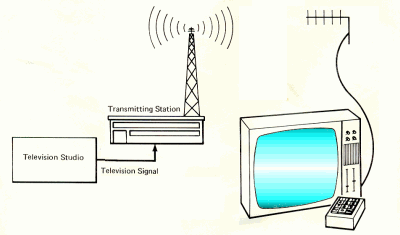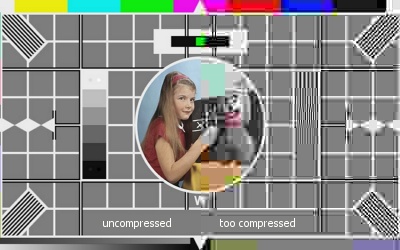Do I need to buy a booster?
 Brian Butterworth published on UK Free TV
Brian Butterworth published on UK Free TV With analogue television, it has often been necessary to buy an amplifier to improve the quality of the television picture, or to supply a steady on several televisions fed from the same aerial.
Many people have asked if it necessary to investing in a signal booster for Freeview.
"Analogue television" means is that the sound and pictures are broadcast using signals that are an "analogue" of the input. The sound and picture are transmitted from the source as electrical signals, then as radio waves and then back to sound and picture again.
In an analogue television camera, the image is scanned 25 times a second from side to side, from top to bottom and back. Where a lot of light is scanned, a high voltage is produced. Where no light is scanned, no voltage is produced. The output voltage is the same ratio to amount of light at scanned.
Leaving aside the technically, this signal is sent to the transmitter. The transmitter emits a radio wave on a known frequency, which is varied by the incoming voltage.

A microphone also converts the sound vibrations it picks up into a voltage, which when sent to the transmitter is added to another radio transmission frequency.
The signals are received by a television aerial pointing at the transmitter and converted back to very weak electrical signals. The sound is amplified and sent to a loudspeaker, and a picture created on the TV screen.
So on an analogue television, if the incoming signal is weak then the picture is dull as the background noise (the snow scene seen when an analogue television is not tuned) makes the picture less watchable.
The best analogue television set equipped with a great TV aerial located near to a high powered transmitter will produce brilliant pictures and clear sound. A poor set with an inadequate aerial or substandard cable will not.
If a weak signal is fed to a booster device, this will make the picture appear better on the television set or sets. It is often worth the investment.
Digital television
In a digital studio, the voltages from the cameras and microphones are not sent directly to the transmitter. It is converted into a stream of numbers inside a computer. The input voltage relates directly to the number in the computer. By sampling the input at a regular frequency, it is therefore possible to both store and transmit the information digitally this is what computers are good at.
It is therefore possible to take these numbers and generate a sound and picture output from them. However, the amount of information generated is over 240Mb/s, 30 times the rate of the fastest broadband connection.
Buy using computational techniques on this information the data can be compressed to as low as 2Mb/s, with as little as 6Mb/s being required for a good quality picture. These data compression techniques are called "lossy" because the reconstructed images are not identical to the originals, but look virtually similar to human eyes.

Digital television uses the same transmission frequencies as analogue uses, known as C21 to C68. The digital data is sent using a system called COFDM (Coded Orthogonal Frequency-Division-Multiplexing) which can carry data at a rate of 18Mb/s or 24Mb/s. Several television channels and some radio stations can be multiplexed together to produce exactly this amount of data.
At the receiver, it must be able to decode every single bit from these transmission multiplexes. A single error is impossible to correct for, so the decoder must have no errors.
Until switchover happens, the Freeview signals are being broadcast at very, very low power levels. However the COFDM system and sensitive digital equipment will, as long as the signal can be found and decoded there will be pixel-perfect reconstruction of the television channel. If the signal is drowned out by interference (especially from analogue transmissions) then no picture or sound will be output.
If the TV aerial installation you have provides you with all the Freeview channels, there is nothing to worry about.
If you are missing some channels because the signal is just too weak the best place to start is by improving the aerial, see Freeview reception - All about aerials. A bigger, higher, better designed aerial will always be the most sensible way to get perfect reception.
If you want to supply a signal to several sets, where the incoming signal is being "split" to serve several Freeview boxes, a masthead amplifier will be effective. This is because the signal is already of good quality and is being repeated for several sets.
However, if you are not getting a good signal from your aerial, a booster by the TV set will probably not help as this will simply boost the background interference as much as the Freeview signal.
In circumstances where an amplifier that has improved a picture on an analogue, it may be unsuitable for Freeview reception. Sometimes they will block one or more multiplex, where disconnecting the amplifier will restore the channels.
Jerre: You are not in a good Freeview reception area until switchover, so you might only get the BBC channels from a Freeview box.
If you have a "communal" reception system, you would normally have to speak to whoever manages the system.
You might find you get the best results using a Freesat box and the satellite connection.
| link to this comment |
10:50 PM
I thought as much, I've asked the building managers to get someone in too look at the aerial but I fear your answer of the Freesat route will be the way to go.
I dont suppose the fact that I also have a BT Vision box will make any difference will it? It's the black one not the silver version.
Thank you for your quick response.
| link to this comment |
7:31 AM
Jerre - Your BT Vision receiver is designed to work with a Freeview connection with it's on demand content being delivered via your broadband connection. So if as Brian has pointed out you are unlikely to have a satisfactory "Freeview" reception where you are then I think "Freesat" will be the better option where you can also connect to a satellite outlet..
| link to this comment |
1:18 PM
Bristol
Why do I get an excellent picture on Freeview BBC1 and BBC 2 and some other channels, but regular pixelation and break up on ITV 1 & ITV 4 etc? Post Code BS48 4TZ - new roof aerial.
| link to this comment |
Bern's: mapB's Freeview map terrainB's terrain plot wavesB's frequency data B's Freeview Detailed Coverage
6:44 PM
Bern Finch: If ITV1 is breaking up make sure that the channels stored are being received from the transmitter that the aerial is pointing towards. If you are using Mendip this is C54, but you could have found a signal from Backwell on C28 or Wenvoe on C44 earlier in the scan. Regarding ITV4, this is carried on Mux ArqB which is currently shown as giving poor reception by the Digital UK postcode checker. The COM muxes from Mendip are shown as having good reception from 28th September 2011 when the frequencies are changed,so a re-tune will be necessary on that date. Reception improves further on 28th March 2012 when the full DSO power is adopted.
| link to this comment |
9:59 PM
I have an older tv in one of the rooms.Up until the 23rd of June i was getting a brilliant picture but now i cant get any picture after trying to retune as stated in adverts.Will i need to get freeview.Thank you
| link to this comment |
8:21 AM
john: Maybe yes, although as these retuning adverts are intended for people who are already using Freeview equipment its really the case of whether or not you are, because if you are, then your box could possibly not be compatible with technical aspects of the new system.
Maybe you could clarify on this regarding what it is you are using and your location.
| link to this comment |
9:36 PM
We have a 4 year old digital aerial on the roof and 12 months ago bought a new digital TV and PVR for the lounge. Until a couple of weeks ago we could get all channels on both. Now the TV is showing 'no signal' for anything other than the main BBC and ITV channels. The TV in another room has also started losing some channels, that's also a digital and about 3 yrs old. Do we need a booster? Getting conflicting info from Panasonic and the shop we bought from (Richer Sounds, Bristol). To test the TV I was asked to plug the aerial direct into the TV and it then gave us all channels on TV but nothing else worked. Replugged everything as set up by engineer when TV etc installed and still retained all channels on TV. Today we have lost all channels except BBC and ITV again on TV. PVR is fine. Any suggestions?
| link to this comment |
10:18 AM
Sue B: If you received the channels OK up until a couple of weeks ago, then there is a possibility that the reason for not doing so now is maybe caused by transmitter upgrading work, this being where your post code is essential for verifying purposes as well as looking at what is possible in your area.
Quite a number of people in various areas of the country have experienced similar situations to yourself during upgrading work, but once again a post code is essential to check on this possibility.
The fact that your TV works with the aerial coupled directly into it just simply means that you are on the verges of receiving a working signal and no more, anything placed in line with the aerial reducing the level hence the picture glitches or vanishes.
If however none of the possibilities mentioned apply, then an aerial amplifier mounted as near to the aerial as possible will definitely help the situation.
| link to this comment |
2:58 PM
Clevedon
JB38: My post code is BS21 6LD; how do I check. The EPG seems to work OK, but if we select a channel other than BBC and ITV chances are it then takes an age and tells us 'no signal'.
| link to this comment |
Sue's: mapS's Freeview map terrainS's terrain plot wavesS's frequency data S's Freeview Detailed Coverage